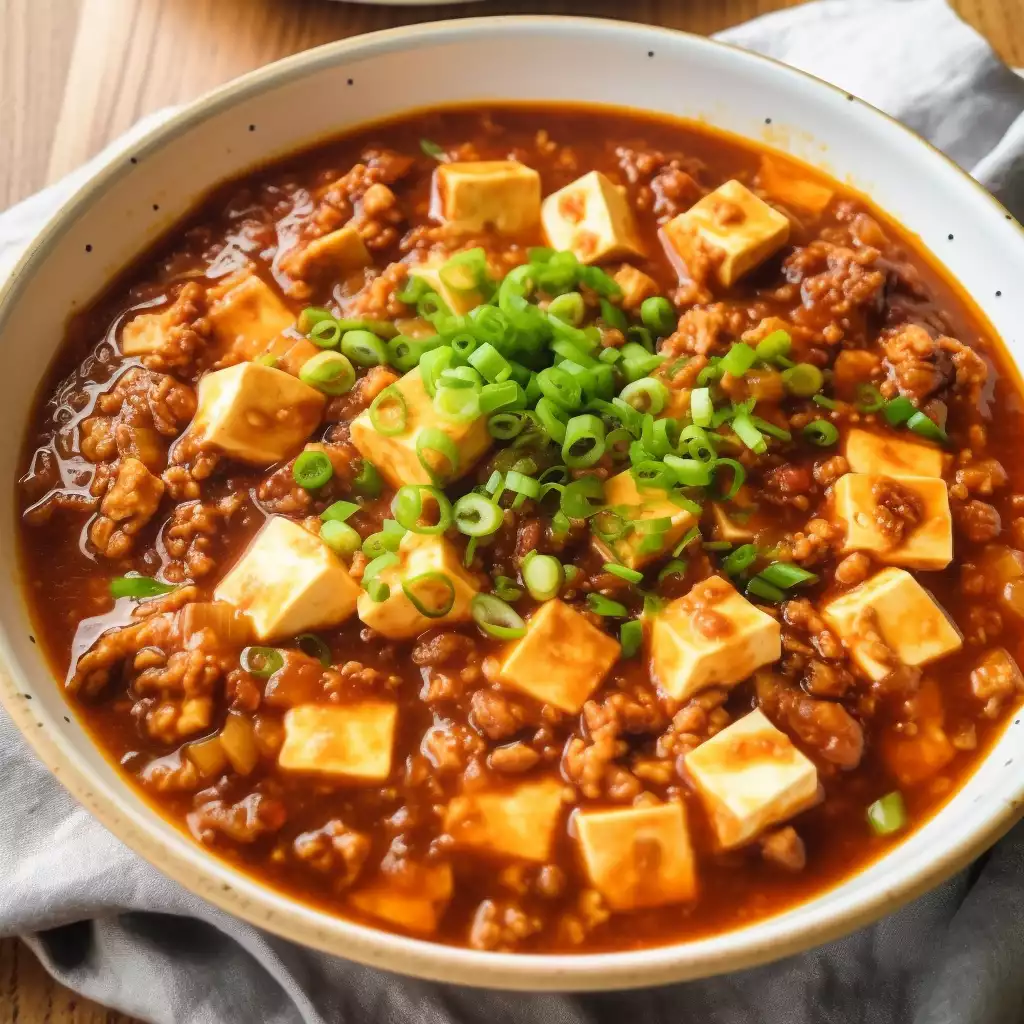
Mapo Tofu is a classic Sichuan dish known for its bold flavors and fiery kick. Originating from China, this dish has made its way into kitchens worldwide, beloved for its comforting warmth and satisfying umami taste.
Despite its complex flavors, Mapo Tofu is surprisingly easy to make, making it an ideal choice for both beginner and seasoned cooks alike.
At the heart of this dish lies tofu, a versatile ingredient that absorbs the rich flavors of the sauce while providing a creamy texture.
Combined with minced beef, Sichuan bean paste, and fermented black beans, Mapo Tofu offers a delightful blend of savory, spicy, and slightly numbing flavors characteristic of Sichuan cuisine.
The addition of garlic and green onions enhances the aroma and freshness of the dish, while Sichuan peppercorns impart a distinctive tingling sensation that sets Mapo Tofu apart.
One of the best things about Mapo Tofu is its adaptability. Whether you’re a meat lover or a vegetarian, you can easily customize this dish to suit your preferences.
Plus, with readily available ingredients and simple cooking techniques, you can whip up a delicious batch of Mapo Tofu in no time. So why not bring a taste of Sichuan cuisine into your kitchen and delight your taste buds with this flavorful and comforting dish?
Expert Tip: Adjust the spiciness level according to your preference by adding more or less Sichuan peppercorns and chili paste.
Tofu: Tofu serves as the main ingredient in Mapo Tofu, offering a delicate and creamy texture that complements the bold flavors of the dish. Its neutral taste allows it to absorb the rich sauce, creating a satisfying contrast to the savory meat and spices.
Minced Meat (Beef): Minced beef adds depth and richness to Mapo Tofu, infusing the dish with hearty flavor. Its savory notes complement the spicy undertones of the sauce, creating a satisfyingly robust dish.
Sichuan Bean Paste: Sichuan bean paste, also known as doubanjiang, is a key ingredient in Mapo Tofu, providing a complex and spicy flavor profile. Made from fermented broad beans and chili peppers, it adds depth and umami to the dish, contributing to its signature taste.
Black Beans (Fermented): Fermented black beans add a unique depth of flavor to Mapo Tofu, with their salty and slightly sweet taste. These beans lend a complex umami flavor to the dish, enhancing its overall richness.
Sichuan Peppercorns: Sichuan peppercorns are renowned for their numbing and citrusy flavor, adding a distinctive dimension to Mapo Tofu. They provide a tingling sensation that complements the dish’s spicy heat, creating a memorable dining experience.
Garlic: Minced garlic adds aromatic depth to Mapo Tofu, infusing the dish with its pungent flavor. It enhances the overall complexity of the sauce, contributing to its rich and savory profile.
Green Onion: Chopped green onions lend a fresh and vibrant flavor to Mapo Tofu, offering a crisp contrast to the dish’s bold and spicy elements. They provide a pop of color and a subtle onion flavor, enhancing the overall presentation and taste.
Soy Sauce: Soy sauce adds depth and umami to Mapo Tofu, enriching the sauce with its savory flavor. It balances the heat of the spices and enhances the overall complexity of the dish.
Cornflour: Cornflour serves as a thickening agent in Mapo Tofu, helping to create a velvety and luscious sauce. It binds the ingredients together and adds body to the dish, ensuring a satisfyingly thick and flavorful texture.
Oil: Vegetable oil is used for frying and sautéing in Mapo Tofu, providing a neutral base for cooking the ingredients. It helps to develop the flavors of the dish and ensures that the ingredients are evenly cooked.
Beef Broth: Beef broth serves as the liquid base for Mapo Tofu, infusing the dish with rich and savory flavor. It adds depth to the sauce and ensures that the dish is moist and succulent, enhancing its overall taste and texture
Expert Tip: For a richer flavor, use homemade beef broth instead of store-bought. Simmer beef bones with aromatics like onions, garlic, and ginger for several hours to create a deeply flavorful broth.
Expert Tip: Experiment with different types of tofu, such as silken or firm, to vary the texture of the dish. Silken tofu creates a softer texture, while firm tofu holds its shape better during cooking.
Mapo Tofu originated from the Sichuan province of China and is named after a pockmarked old woman (“Mapo”) who is said to have created the dish. It has since become a beloved staple of Sichuan cuisine and gained popularity worldwide for its bold flavors.
Yes, Mapo Tofu is known for its spicy flavor profile, thanks to ingredients like Sichuan peppercorns and Sichuan bean paste. However, the level of spiciness can be adjusted according to personal preference by varying the amount of chili paste or peppercorns used in the recipe.
Yes, Mapo Tofu can easily be made vegetarian by omitting the minced meat and using vegetable broth instead of beef broth. Tofu provides a satisfying protein source, and the dish remains flavorful with the addition of aromatic spices and savory sauces.
Leftover Mapo Tofu can be stored in an airtight container in the refrigerator for up to 3-4 days. To reheat, simply transfer the desired portion to a saucepan or microwave-safe dish and gently heat until warmed through. Add a splash of water or broth if needed to maintain the sauce’s consistency.
While Mapo Tofu can be frozen, the texture of the tofu may change slightly upon thawing. It’s best to freeze the dish in an airtight container for up to 1-2 months. Thaw overnight in the refrigerator before reheating as directed.
Here are some more recipes for you to enjoy! If you my recipes don’t forget to rate and leave a comment.
If you have any recipe suggestions, please do not hesitate to ask me. A great way to stay in contact with me is through Instagram, Facebook, Twitter and YouTube. Don’t forget to tag me @CookwithNabeela in your recipe photos!

Subscribe now to receive my latest recipes directly in your inbox. Stay up-to-date and never miss out!

I love to cook! I want to share with you my favourite, delicious family-friendly recipes. I want to inspire you to create fantastic food for your family every day.
Add your first comment to this post